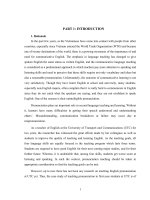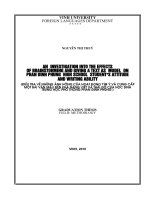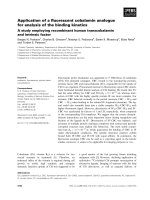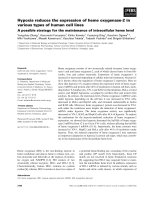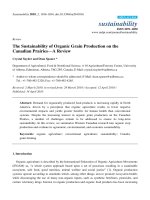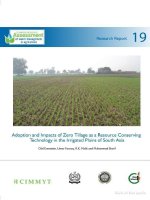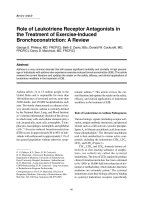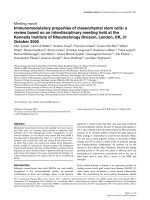The socio-economic impacts of the COVID-19 pandemic: A review
Bạn đang xem bản rút gọn của tài liệu. Xem và tải ngay bản đầy đủ của tài liệu tại đây (147.7 KB, 5 trang )
Int.J.Curr.Microbiol.App.Sci (2020) 9(11): 562-566
International Journal of Current Microbiology and Applied Sciences
ISSN: 2319-7706 Volume 9 Number 11 (2020)
Journal homepage:
Review Article
/>
The Socio-economic Impacts of the COVID-19 Pandemic: A Review
D. N. Nayak, R. Kumar* and C. V. Savalia
Department of Veterinary Public Health and Epidemiology, College of Veterinary Science &
Animal Husbandry, Navsari Agricultural University, Navsari-396 450. Gujarat, India
*Corresponding author
ABSTRACT
Keywords
COVID-19,
Pandemic, Public
health, Socioeconomic, Impacts,
Quarantine,
Industry
Article Info
Accepted:
07 October 2020
Available Online:
10 November 2020
The COVID-19 pandemic has tremendously given a huge shock on world economy. The
prolonged lockdown in most of the countries lead to disruption of demand and supply
chains. The pandemic not only resulted extraordinary burden on healthcare sector with
abrupt spike in cases every passing day, but also caused deleterious social and
psychological impacts on people especially those belonging to the economically deprived
sections of society together with loss of lives and jobs. Governments, imposed restrictions
like social distancing, complete travel bans and shutdown of different institutions in total,
commercial offices and industries, worldwide. The need for medical supplies increased
and countries were unable to cope with limited resources like protective wares for
healthcare workers and corona warriors. Panic-buying and unnecessary huge stocking of
essential commodities by people lead to their shortfall in the availability of market stores.
This pandemic is likely to have a long term impact in the lives of people the world over in
both as social and economical. The overall socioeconomic effects of COVID-19 on
various aspects of the world economy have been summarized in this short review.
declared it a public health emergency of
international concern on 30th January 2020
(WHO, 2020b, WHO, 2020c). The lock-down
in countries which contribute largely to the
global economy lead to the halting of services
and production, which resulted in a standstill
in various supply chains and thus, affected the
global economy brutally (Ebrahim et al.,
2020). Educational institutions have been shut
down. The uncertainty and postponement of
examinations also stressed young minds (Roy
et al., 2020). People who were quarantined
had to deal with separation from family and
sense of uncertainty (Chaterji and Chauhan,
2020).
Introduction
The first case of Corona virus was reported in
Wuhan, China (Huang et al., 2020) in the mid
of December 2019. Within short time the
virus spread to most of the countries of the
world with surprise of doctors, scientists,
public health personnel as well as the
government functionaries. The unprecedented
spread with a very high fatality rate in some
countries has resulted in extreme public
health measures including a total lockdown
being adopted in many countries. Looking at
the outbreak and rapid spread in numerous
countries, World Health Organization (WHO)
562
Int.J.Curr.Microbiol.App.Sci (2020) 9(11): 562-566
numerous appeals by government, police and
doctors, people ignore the importance of
social distancing and basic hygiene measures.
The psychological health issues are also
expected to increase day by day during this
pandemic (Roy et al., 2020)
Effects of quarantine
During SARS it was seen that longer the
duration of quarantine more the chances of
patients as well as acquaintances exhibiting
PTSD symptoms (Hawryluck et al., 2004).
Bai et al., (2004) in a study, observed that
health workers also suffered from fatigue,
detachment,
nervousness,
irritability,
sleeplessness,
poor
concentration,
indecisiveness,
deteriorating
work
performance and consideration of resignation.
Behavioral changes such as evading crowded
places and delayed return to normalcy after
the quarantine period were also seen (Cava et
al., 2005). Reynolds et al., (2009) mentioned
that a person with a history of any form of
psychiatric ailment was associated with the
experience of anger and anxiety, following 4
to 6 months post quarantine period. Recent
evidence suggests that individuals who are
kept in isolation and quarantine, experienced
significant distress expressed by anxiety,
anger, confusion and post-traumatic stress
symptoms (Brooks et al., 2020). When
quarantined, the health care workers showed
more severe symptoms of post-traumatic
stress than general public. They experienced
humiliation, loss of income and greater
psychological impact (Chaterji and Chauhan,
2020). Increased anger, fright, frustration,
vulnerability,
seclusion,
loneliness,
unhappiness and concern was observed in the
workers noted by Taylor et al., (2008).
Health-care workers were in the illusion that
they had contagious disease and they may
infect others. Since the beginning of the
corona virus pandemic the use of masks and
sanitizers has increased (Feng et al., 2020)
resulting in unavailability in the market. A
shortage of personal protective equipment
endangers health workers worldwide (WHO,
2020c). It is a major cause of concern among
medical personnel especially in a densely
populated country like India with lack a
robust healthcare infrastructure. Despite
Impact on various sectors
Agriculture
The COVID-19 outbreak which resulted in
the shutting down of hotels, restaurants and
food industries resulted in nearly 20% drop in
demand of agricultural commodities. An array
of protective measures imposed by countries
all over the world had slowed down
transportation of products resulting in
pronounced implications on perishable
commodities such as meat, fruits and
vegetables. Panic buying further complicated
shortages of various commodities as
expressed by Nikola et al., (2020).
Manufacturing industry
The COVID-19 pandemic has slowed down
the economy and disrupted businesses of all
sectors round the world. The manufacturing
of various commodities has slowed down
with shut down of many small scale industries
resulted in millions of jobs being lost
implicating a financial burden on families of
workers. The families with only single
earning member suffered the great and have a
very long lasting impact. Even in the factories
where work resumed after lockdown, the
number of workers in one shift has to be
curtailed in order to follow social distancing
rules due to which the output of goods
forcibly reduced. Even many workers were
unwilling to resume work due to the fear of
contracting infection. The countries like India
has experienced an unimaginable migrant
crisis. Migrant workers and labourers left the
cities due to uncertainty and disappointment
563
Int.J.Curr.Microbiol.App.Sci (2020) 9(11): 562-566
of their future and returned to their home
town with the hope of a better life. The losses
in national and international trade, reduced
cash flow in the market and slowdown in the
revenue growth of many countries has led to
contraction of the GDP especially of poor and
developing countries. Many countries are
already in a huge economic debt. The ‘work
from home’ option is not viable in
manufacturing industries. Many companies
have made large number of layoffs resulting
in job losses. Also less number of working
staff lead to a disruption of supply chains
(Nikola et al, 2020).
asymptomatic and frontline healthcare staff is
vital (Tanne et al., 2020). High costs,
shortages of protective equipment including
N95 face masks, and low numbers of ICU
beds and ventilators have ultimately
undermined in the delivery of patients’ care.
Doctors and nurses who contracted the
infection and even lost their lives while
serving patients have resulted in increased
burden on the other staff. With rapid tall of
deaths is rapidly increasing the mortuaries as
well as cremation centers are unable to deal
with the sudden inflow of dead bodies, and
hence in many instances dead bodies have
been kept for days in hospital premises
predicting the risk of infection to staff as well
as other patients (Nikola et al., 2020).
Education
Close to 900 million learners have been
affected by the closure of educational
institutions (UNESCO, 2020). In order to
prevent spread and carriage of the virus to
susceptible individuals, over 100 countries
imposed a nationwide closure of educational
facilities. Children from poor families are
unable to avail free school meals.
Pharmaceutical industry
The worldwide supply contribution of major
active pharmaceutical ingredients from US
and India (18%), China (13%) and the
European Union (26%) has adversely
affected. China is the leading exporter of
medical devices (39.3%) to the US. Due to
the pandemic there has been a slowdown in
production, restrictions in supply which lead
to loss of revenue (COVID-19 USA, 2020).
Conversely, companies engaged in vaccine
development have opportunities and with USbased companies including Johnson &
Johnson, Vir Biotechnology, Novavax and
Nano Viricides announcing collaborative
plans to develop a viral vaccine (NIH, 2020).
Moreover, populations with a higher income
and urban base have better access of
technology for online education compared to
lower income groups and those living in rural
areas. Parents who have suffered job loss and
pay cuts during this period have urged schools
to forego the fees of their children. Apart
from primary education, the pandemic has
also impacted higher education (Nikola et al.,
2020). In the United Kingdom as well as USA
all non COVID research has been put on hold
by the national funding agencies so that
clinically trained staff provide their services
at the frontline (DHSC and NIH, 2020).
Hospitality, tourism and aviation
The hotel, tourism and aviation were among
most hard-hit industries with non-permanent
workers facing potentially devastating hard
ships, from jobs being lost, salaries cut or not
paid to placing staff on furlough. Italy, a
famous tourist destination saw record number
of cases in the early days of the pandemic.
The World Travel and Tourism Council has
Healthcare
The risk faced by health care workers is an
extraordinary challenge for healthcare
systems worldwide. Hence, testing for
564
Int.J.Curr.Microbiol.App.Sci (2020) 9(11): 562-566
predicted job loss of 50 million in the global
travel and tourism sector (World Economic
Forum, 2020). The travel industry witnessed
an exceptional wave of cancellations due to
postponement or non-organization of largescale sports and tournaments, religious and
cultural events. Globally, borders were closed
and travel suspensions implemented on most
of the places. Apart from these, people and
small businesses that thrived on income from
tourists like guides, local artists and crafts
man, private transporters completely shut
down placing them under a huge financial
constrain.
References
Bai, Y., Lin, C. C., Lin, C. Y., Chen, J. Y., Chue,
C. M., and Chou, P. 2004. Survey of
stress reactions among health care
workers involved with the SARS
outbreak. Psychiatric Services, 55:10551057.
Brooks, S., Webster, R., Smith, L., Woodland, L.,
Wessely, S., Greenberg, N. and Rubin, G.
2020.The psychological impact of
quarantine and how to reduce it: rapid
review of the evidence. Lancet. 395:912920.
Cava, M.A., Fay, K.E., Beanlands, H.J., McCay,
E.A., and Wignall, R. 2005. The
experience of quarantine for individuals
affected by SARS in Toronto. Public
Health Nursing, 22:398 - 406.
Chatterje, K. and Chauhan, V.S. 2020. Epidemics,
quarantine and mental health. Medical
Journal Armed Forces India, 76(2): 125–
127.
COVID-19 USA, 2020. Coronavirus outbreak
measures and effect on the US. Available
from:
countries-usa-covid-19-measuresimpact pharma-hotel-tourism medical/.
covid19. pdf? sfvrsn=96b04 adf_2.
Ebrahim, S.H., Ahmed, Q.A., Gozzer, E.,
Schlagenhauf, P. and Memish, Z.A. 2020.
Covid-19 and community mitigation
strategies in a pandemic. British Medical
Journal, 368.
Feng, S., Shen, C., Xia, N., Song, W., Fan, M.,
Cowling, B.J., 2020. Rational use of face
masks in the COVID-19 pandemic.
Lancet Respiratory Medicine.
Hawryluck, L., Gold, W. L., Robinson, S.,
Pogorski, S., Galea, S. and Styra, R. 2004.
SARS control and psychological effects of
quarantine, Toronto, Canada. Emerging
Infectious Diseases, 10:1206-1212.
Huang, C. Wang, Y., Li, X., Ren, L., Zhao, J. and
Hu Y. 2020. Clinical features of patients
infected with novel corona virus in
Wuhan, China. Lancet, 395(10223):497506.
Nicola, M., Alsafi, Z. Sohrabi, C., Kerwan, A.,
Ahmed Al-Jabird, Iosifidis, C., Agha, M.
In conclusion and perspective, more than the
effect of disease on health, fears of recession
and uncertain future cause more panic in the
people. Hence, a strong political leadership
with acumen for better policy making in
healthcare and industry as well as schemes
which benefit the economically vulnerable
sections of the society need to be
implemented in order to reduce the impact of
this pandemic. Immediate relief measures and
long term planning is required to pull nations
out of the economic crisis. Encouraging new
entrepreneurs to build robust and sustainable
business models, which do not crash during
such unpredictable disasters is also important.
Above all helping the less fortunate around us
to rebuild their lives by giving and sharing is
of foremost importance as the sociopsychological impact of such disaster is far
more than its economic impact.
Acknowledgement
The authors are grateful to acknowledge the
support rendered by the Dean, Veterinary
College and Director of Research & Dean,
PGS, Navsari Agricultural University,
Navsari, Gujarat, India by providing
necessary facilities and resources to write this
review article.
565
Int.J.Curr.Microbiol.App.Sci (2020) 9(11): 562-566
and Agha, R. 2020. The socio-economic
implications of the corona virus pandemic
(COVID-19): A review. International
Journal of Surgery, 78: 185-193.
NIH, 2020. NIH Clinical Trial of Investigational
Vaccine for COVID-19 begins, Available
from:
/>NIH, 2020. NIH Shifts Non-mission-critical
Laboratory Operations to Minimal
Maintenance Phase, National Institutes of
Health
(NIH),
Available
from:
phase.
NIHR, 2020. DHSC issues guidance on the
impact of COVID-19 on research funded
or supported by NIHR, Available from:
/>Reynolds, D. L., Garay, J. R., Deamond, S. L.,
Moran, M. K., Gold, W. and Styra, R.
2008. Understanding, compliance and
psychological impact of the SARS
quarantine experience. Epidemiology and
Infection, 136:997 - 1007.
Roy, D., Tripathy, S., Kar, S. K., Sharma, N.,
Verma S. K., and Kaushal, V. 2020. Study
of knowledge, attitude, anxiety &
perceived mental healthcare need in
Indian population during COVID-19
pandemic. Asian Journal of Psychiatry,
51:102083.
Tanne, J. H. Hayasaki, E., Zastrow, M., Pulla, P.,
Smith, P. and Rada, A. G., Covid-19:
2020. How Doctors and Healthcare
Systems Are Tackling Corona virus
Worldwide, British Medical Journal,
18:368.
Taylor, M. R., Agho, K. E., Stevens, G. J. and
Raphae,l B. 2008. Factors influencing
psychological distress during a disease
epidemic: data from Australia's first
outbreak of equine influenza. BMC Public
Health, 8:347.
UNESCO, 2020. COVID-19, Educational
Disruption and Response, UNESCO,
Available
from: />on-emergencies/coronavirus-school
closures.
WHO, 2020a. Corona virus Disease 2019
(COVID-19) Situation Report–46. URL
/>WHO, 2020b. Rolling Updates on Corona virus
Disease
(COVID-19).
URL
/>/novel-coronavirus-2019/events-as-they
happen.
World Economic Forum, 2020. This is how
corona virus could affect the travel and
tourism industry. Available from:
https://www.
weforum.org/agenda/2020/03/worldtravel-coronavirus-covid19-jobspandemictourism- aviation/.
How to cite this article:
Nayak, D. N., R. Kumar and Savalia, C. V. 2020. The Socio-economic Impacts of the COVID19 Pandemic: A Review. Int.J.Curr.Microbiol.App.Sci. 9(11): 562-566.
doi: />
566
